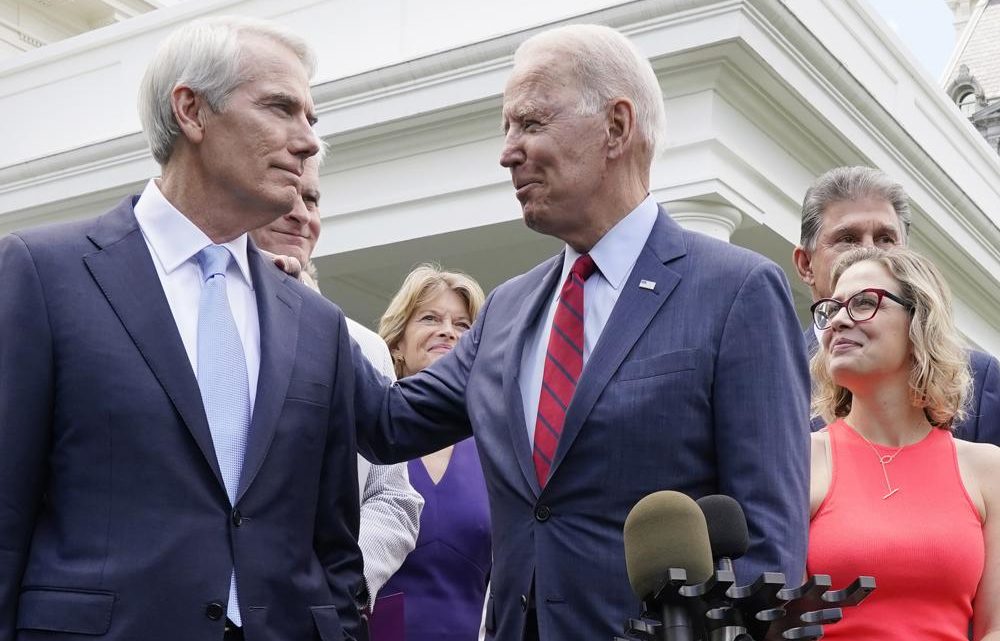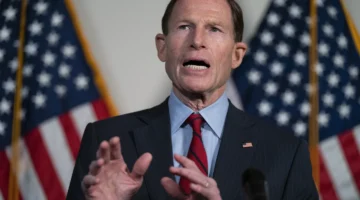Biden taking bipartisan infrastructure deal on the road
WASHINGTON (AP) — President Joe Biden will look to sell voters on the economic benefits of the $973 billion infrastructure package while in Wisconsin on Tuesday, hoping to boost the bipartisan agreement that is held together in large part by the promise of millions of new jobs.
Biden will travel to La Crosse, population 52,000, and tour its public transit center, followed by a speech about the infrastructure package announced last week.
The president presented his message to Democratic donors on Monday that the agreement was a way for the United States to assert the principles of democracy and the economic might that can come from dramatic investments in the country’s economic future.
“This infrastructure bill signals to the world that we can function, we can deliver,” Biden said. “We can do significant things, show that America is back.”
White House officials issued an internal memo that highlights how the largest investment in transportation, water systems and services in nearly a century would boost growth. The memo notes that the total package is four times the size of the infrastructure investment made a dozen years ago in response to the Great Recession and the biggest since Franklin D. Roosevelt’s New Deal in the 1930s.
It also emphasizes an analysis suggesting that 90% of the jobs generated by the spending could go to workers without college degrees, a key shift as a majority of net job gains before the pandemic went to college graduates.
“This is a blue-collar blueprint to rebuild America,” the memo says.
Potential economic gains were a shared incentive for the group of Democratic and Republican senators who agreed to the deal on Thursday. But the process briefly fell into disarray late last week as Biden suggested the deal would be held up until he also received a separate package for infrastructure, jobs and education that would be determined solely by Democrats through the budget reconciliation process.
Biden said Saturday that this was not a veto threat, and by Sunday the package appeared back on track.
White House press secretary Jen Psaki said Monday that Biden is “eager” for both bills to be approved by Congress and that the president is going to “work his heart out” to make it happen.
“The president intends to sign both pieces of legislation into law,” Psaki said at her daily briefing.
Approval of both bills by Congress remains a long haul with this summer’s initial votes expected in July. Senate Republican leader Mitch McConnell questioned the legislative process ahead and mounted fresh obstacles while speaking Monday in Kentucky.
McConnell said he has not yet decided whether he will support the bipartisan package, but he wants Biden to pressure House Speaker Nancy Pelosi and Senate Democratic leader Chuck Schumer to say they will allow the bipartisan arrangement to pass without mandating that the much larger and broader follow-up bill be in place.
“I appreciate the president saying that he’s willing to deal with infrastructure separately, But he doesn’t control the Congress,” McConnell said at a press conference in Louisville.
The two bills had always been expected to move in tandem, and that is likely to continue as Biden drops his veto threat but reaches across the aisle for the nearly $1 trillion bipartisan package as well as his own broader package. The Democratic leaders are pressing ahead on the broader bill, which includes Biden’s families and climate change proposals, as well as their own investments in Medicare, swelling to some $6 trillion.
“The president intends to sign both pieces of legislation into law,” Psaki said at her daily briefing.
Approval of both bills by Congress remains a long haul with this summer’s initial votes expected in July. Senate Republican leader Mitch McConnell questioned the legislative process ahead and mounted fresh obstacles while speaking Monday in Kentucky.
McConnell said he has not yet decided whether he will support the bipartisan package, but he wants Biden to pressure House Speaker Nancy Pelosi and Senate Democratic leader Chuck Schumer to say they will allow the bipartisan arrangement to pass without mandating that the much larger and broader follow-up bill be in place.
“I appreciate the president saying that he’s willing to deal with infrastructure separately, But he doesn’t control the Congress,” McConnell said at a press conference in Louisville.
The two bills had always been expected to move in tandem, and that is likely to continue as Biden drops his veto threat but reaches across the aisle for the nearly $1 trillion bipartisan package as well as his own broader package. The Democratic leaders are pressing ahead on the broader bill, which includes Biden’s families and climate change proposals, as well as their own investments in Medicare, swelling to some $6 trillion.
The prospect of additional economic gains might be a way to garner public support and soothe partisan tensions. Biden also faces pressure from Democrats such as New York Rep. Alexandria Ocasio-Cortez, who told NBC’s “Meet the Press” that the spending isn’t as huge as it might seem because the sums are spread out over multiple years.
The eight-page White House memo comes from Brian Deese, director of the National Economic Council, and senior adviser Anita Dunn. It indicates that the $110 billion for roads and bridges would help relieve traffic and congestion that costs the economy over $160 billion annually. The memo justifies the $48.5 billion planned for public transit by citing studies that link light rail and buses to increased earnings and employment for workers. It defends the $66 billion for repairs and upgrades for rail lines by saying that current delays and disruptions weigh on growth.
The bipartisan agreement also would help nurture the market for electric vehicles, improve broadband access, repair water lines and create resilience against damage from extreme weather events.
Meanwhile, the White House and Congress are pushing ahead on separate infrastructure legislation, a top priority of the administration that is shared by many lawmakers interested in securing federal funds for long-sought road, highway, bridge and other construction projects back home.
This week, the House is scheduled to vote on a highway, transit and water infrastructure bill that would invest up to $715 billion over five years. It overlaps parts of the bipartisan agreement and could become a building block toward the Democrats’ broader package coming later this summer or fall.
The bill contains many of the priorities that Biden has set, including $45 billion to replace lead water service lines throughout the nation and $4 billion for electric vehicle charging stations, as well as a big boost in spending for transportation programs focusing on repairing existing roads and bridges.
It also opens the door to nearly 1,500 requests from lawmakers that would fund specific projects back in their congressional districts, moving Congress a step closer toward a return to earmarked spending.
___
Associated Press writers Lisa Mascaro and Kevin Freking in Washington and Bruce Schreiner in Louisville, Ky., contributed to this report.




No Comment